By conducting these experiments in the non-active plant, the technicians can assess how different processes work and the impact they have on the materials used, while maintaining safety. Once fully tested, new processes can be transferred to the active site.

For the last 15 years, UKNNL has operated a full scale, direct replica of the active waste vitrification plant at Sellafield. The actual plant treats highly active waste by boiling down the liquid left over after cleaning and turning it into glass. The test rig enables the UKNNL technical team to experimentally change the parameters of the processes to improve efficiency and incorporate different kinds of waste.
Over the years, the test rig has developed new and emerging technological solutions that have made a real difference to the processing of nuclear waste at Sellafield. For example, by conducting a series of experiments in the test rig, the technical team was able to change the waste loading (the amount of waste that can be included in the glass) from 25% to 28-29%. This means more waste in each container, resulting in fewer containers overall.
The team have also experimented with the kinds of materials that can be included in the glass. Including a broader range of materials in the glass means fewer materials left over and requiring separate treatment and disposal.
One of the most significant areas in which the test rig has had an impact is in the post operational clean out (POCO). During POCO, a lot of liquid is used to clean out the inside of a nuclear facility. The result is a lot of effluent (contaminated water) that contains radioactive components and therefore can’t be discharged into the natural environment.
The UKNNL team used the test rig to develop the process of boiling off the water to leave just the radioactive components, which have far less volume than the effluent itself. They experimented with different waste materials to see what could be incorporated into the vitrification process and worked develop a suitable glass for their long-term handling and storage.
As a result, Sellafield will be able to make substantial financial savings and close down expired facilities more quickly and with less waste to dispose of.
